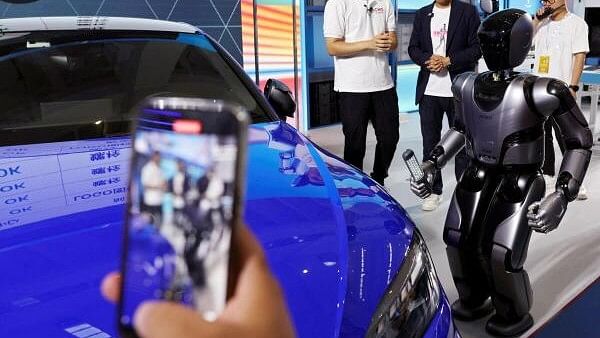
World Robot Conference in Beijing.
Credit: Reuters Photo
Beijing: As China seeks to race ahead in humanoid robot development, its supply chains showcased cheaper and innovative parts at the world robot conference in Beijing, but some executives warn the industry has yet to improve product reliability.
Wisson Technology (Shenzhen), known for its flexible robotic manipulators, doesn’t depend on motors and reducers - transmission devices commonly used in robotics - but instead uses 3D-printed plastics and relies on pneumatic artificial muscles to power its robots.
This less expensive form of production allows it to price its flexible arms at about one-tenth that of traditional robotic arms, said Cao Wei, an investor in Wisson through venture capital firm Lanchi Ventures, in which he is a partner.
Pliable technology will usher in robotic arms at a cost of around 10,000 yuan ($1,404), Wisson said on its website.
"(Wisson’s) pliable arms could be used in humanoids," said Cao, adding that the company has already provided samples to overseas companies that make humanoid robots, without elaborating.
Yi Gang, founder of Shanghai-based Ti5 Robot, a company specialising in integrated joints, highlighted some of the problems he sees in the robotics supply chain.
"The whole supply chain still needs to address issues with product reliability," said Yi, adding that due to defect rates his company can only make products in volumes of up to 1,000.
Harmonic gear, which refers to machinery that plays a key role in motion-control, was a key issue, he said.
China's robotics effort is backed by President Xi Jinping's policy of developing "new productive forces" in technology – a point made in brochures for last week's event.
Across China, the world's largest market for industrial robots, the increasingly sophisticated technology is changing the face of traditional industries such as manufacturing, autos, agriculture, education as well as health and home services.
Gao Jiyang, previously an executive director at Chinese autonomous driving start-up Momenta before founding Galaxea AI, a start-up focused on robot hardware and embodied AI, said the ramp-up in smart driving was leading to advances in robotics.
“Autonomous driving means AI-plus cars, which are also a type of robot,” Gao said.
As the conference wrapped up on Sunday, Premier Li Qiang said it was crucial to implement President Xi's guidelines on the importance of the robot industry.
"The robot industry has broad prospects and huge market potential," Li said, according to China's official Xinhua news agency.
Describing robots as an "important yardstick for technical innovation and high-end manufacturing strength," Li called for efforts to maintain supply chain stability and progress on the international stage.
"It is necessary ... to promote the expansion and popularisation of robots in various fields such as industry, agriculture and service industry," he said. ($1 = 7.1224 yuan)